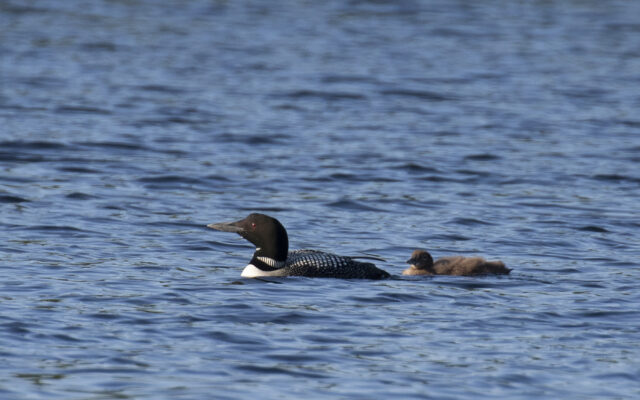
2021 Maine Audubon Loon Count shows importance of long-term studies
Adults up, chicks down, but what does it all mean? As Maine Audubon releases the data from its 2021 Annual Loon Count, it underscores the importance of long-term studies and highlights the need to look beyond the one-day count to understand the data.
The annual loon count takes place on the third Saturday of July, and for the 2021 count, more than 1,400 volunteers jumped into their skiffs, boats, and kayaks on a mostly clear, calm day throughout the state, with early morning fog obscuring viewing on just a small number of lakes. Approximately 50 loon counters who weren’t able to make the count last year due to COVID-19-related reasons once again joined the count, so volunteers were able to look for loons on 328 lakes, 20 more than in 2020.
The result: Estimates for the adult population are up, from 2,974 last year to 3,446 this year. These estimates are for areas south of the 45th parallel — roughly south of a line from Rangeley to Calais — where enough lakes are counted in order to make a reliable estimate.
Loon Count Manager Tracy Hart says, “We had been watching a two-year decline in the adult population that began in 2019 and showed a further reduction in 2020. We are happy to report that adult numbers are back up this year and estimated to be even higher than ever, continuing the general upward trend and recovery that we have seen throughout the history of the loon count.”
However, chick estimates were down from 414 last year to 224 this year. Hart says it’s too early to tell if that marks a temporary dip or a new trend for loon chicks, but that similar and even more pronounced dips have been noticed multiple times in the 38 years of the Maine Audubon loon count and the chick population has rebounded each time.
She says, “We aren’t certain why chick numbers are down this season, but it is likely a combination of reduced nesting success from early extreme rainstorms which flooded some nests; washouts from boat wakes; aggression from non-nesting loons; chick or egg predation; some nests being abandoned due to human disturbance, and chicks being run over by boats. In addition, sometimes loons simply take a break from nesting — they don’t necessarily breed or breed successfully every year.”
The Annual Loon Count provides a vital snapshot of the population at the same time and with the same methods each year. It is like a barometer that shows biologists how the population is doing compared to prior years and helps track those changes over time.
But there’s still much more to learn about Maine’s loon population. That’s why Hart is particularly excited about the expansion of loon conservation and outreach programs, thanks to new funding sources. Earlier this year, Maine Audubon received a five-year grant to significantly expand the Maine Loon Project, and to partner with Maine Lakes, Lakes Environmental Association, and the Penobscot Indian Nation to work to improve loon productivity and reduce mortality in the state. The new partnership is an exciting opportunity to work with local volunteers to start documenting loon successes and failures in more depth. It will be a complement to the Annual Loon Count, with the count still serving as the cornerstone in tracking the population, and this new effort providing additional avenues to understand and address the issues on individual lakes and ponds.